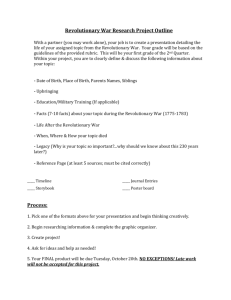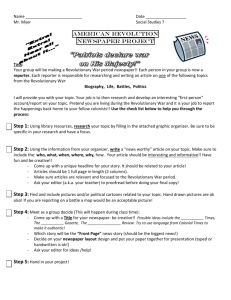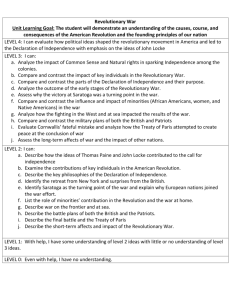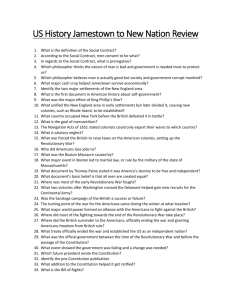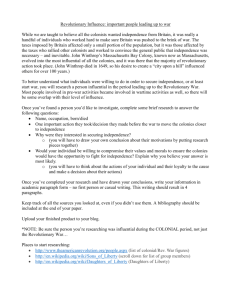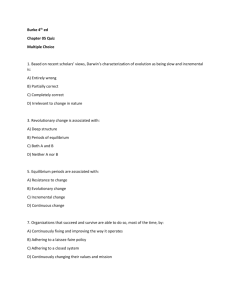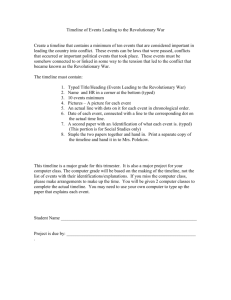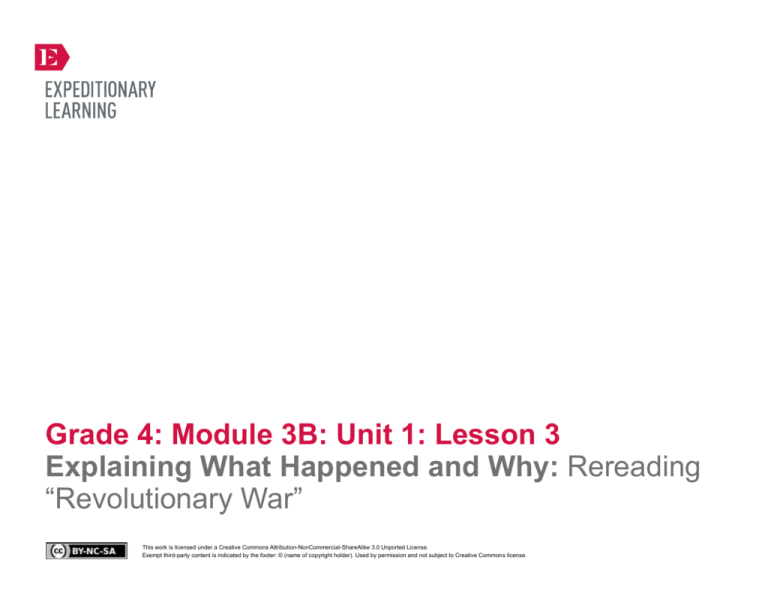
Grade 4: Module 3B: Unit 1: Lesson 3
Explaining What Happened and Why: Rereading
“Revolutionary War”
This work is licensed under a Creative Commons Attribution-NonCommercial-ShareAlike 3.0 Unported License.
Exempt third-party content is indicated by the footer: © (name of copyright holder). Used by permission and not subject to Creative Commons license.
GRADE 4: MODULE 3B: UNIT 1: LESSON 3
Explaining What Happened and Why:
Rereading “Revolutionary War”
Long-Term Targets Addressed (Based on NYSP12 ELA CCLS)
I can determine the meaning of content words or phrases in an informational text. (RI.4.4)
I can summarize informational or persuasive text. (RI.4.2)
I can explain the main points in a historical text, using specific details in the text. (RI.4.3)
Supporting Learning Targets
Ongoing Assessment
• I can use vocabulary strategies to figure out the meaning of content vocabulary words that help me
understand the significant events of the Revolutionary War.
• What Happened and Why graphic organizer
• “Revolutionary War” Summary
• I can summarize the events that led to the American Revolution using evidence from the text
“Revolutionary War.”
• I can justify how certain events leading up to the Revolution caused the Patriots to revolt using evidence
from the text “Revolutionary War.”
Copyright © 2013 by Expeditionary Learning, New York, NY. All Rights Reserved.
NYS Common Core ELA Curriculum • G4:M3B:U1:L3 • June 2014 •
1
GRADE 4: MODULE 3B: UNIT 1: LESSON 3
Explaining What Happened and Why:
Rereading “Revolutionary War”
Agenda
Teaching Notes
1. Opening
• In this lesson, students revisit the text “Revolutionary War,” which they read in Lesson 2. In Lesson 2,
students read the text for the gist and answered text-dependent questions to build a general
understanding of the American Revolution, focusing on RI.4.1 (“I can explain what a text says using
specific details from the text.”) and RI.4.2 (“I can determine the main idea using specific details from
the text.”). Now in Lesson 3, students use evidence from the text as they consider what happened during
the war and to think about why the events happened and how they impacted other events—RI.4.3 (“I
can explain the main points in a historical, scientific, or technical text, using specific details in the
text.”). Students also focus on RI.4.2 (“I can summarize informational or persuasive text.”) by
summarizing the text using the What Happened and Why graphic organizer.
A. Engaging the Reader: Creating a Revolutionary War
Timeline (10 minutes)
B. Reviewing Learning Targets (5 minutes)
2. Work Time
A. Reread “Revolutionary War” to Identify DomainSpecific Vocabulary (10 minutes)
B. Using the What Happened and Why Graphic
Organizer (10 minutes)
C. Summarizing: What Happened and Why (15
minutes)
3. Closing and Assessment
A. Debrief: Create Be a Patriot Anchor Chart (10
minutes)
4. Homework
A. Read your independent reading book for this unit.
• The timeline in this lesson (Opening A) helps students visually see the events in the order that they
happened, and choosing the five most important events helps students think about the events that had
the biggest impact on the war.
• The lesson also sets aside time to dig into some domain-specific vocabulary needed to understand the
text, which addresses RI.4.4 (“I can determine the meaning of content words or phrases in an
informational text.”) Use this as an opportunity to begin interacting with the Word Wall.
• In Unit 1, the vocabulary on the Word Wall helps with students’ understanding of the informational
texts they will read. In Unit 2, the Word Wall expands to include key vocabulary from the literary texts
students will read. These words may include both descriptive and figurative language. All of the words
compiled in Units 1 and 2 will support the writing work students do in Unit 3. As they write and revise
for word choice, students will need to interact with the words they have collected.
• In advance:
– Prepare sets of Revolutionary War timeline cards (one set for each group of four to five students).
Make sure to cut the date and event cards apart; mix each set up so they aren’t in chronological order
or in matched pairs.
– Prepare a Revolutionary War timeline: a piece of chart paper with a line drawn down the center and
the title “Revolutionary War Timeline” written at the top.
– Prepare the Be a Patriot anchor chart.
– Form triads: heterogeneous groups of three students (see Opening A)
– Post: Learning targets.
Copyright © 2013 by Expeditionary Learning, New York, NY. All Rights Reserved.
NYS Common Core ELA Curriculum • G4:M3B:U1:L3 • June 2014 •
2
GRADE 4: MODULE 3B: UNIT 1: LESSON 3
Explaining What Happened and Why:
Rereading “Revolutionary War”
Lesson Vocabulary
Materials
summarize, Patriots, evidence,
timeline, key events, importance,
significant, justify; established (1),
passed, representatives, boycott, selfgovernment, unite (2), delegates, free
and independent states, recognized,
fleet (3), surrendered, treaty (4)
• Highlighters (one per student)
• “Revolutionary War” text (from Lesson 2)
• Revolutionary War timeline cards (one per group)
• Revolutionary War timeline (new; teacher-created; see Teaching Notes)
• Vocabulary Strategies anchor chart (begun in Module 2A, Unit 1, Lesson 3)
• American Revolution Vocabulary notebook (from Lesson 2; one per student)
• 3" x 5" index cards (one per student)
• Word Wall (from Lesson 2)
• What Happened and Why graphic organizer (one per student and one to display)
• What Happened and Why graphic organizer (completed; for teacher reference)
• Equity sticks
• Green colored pencil or thin marker (one per student)
• Be a Patriot anchor chart (new; co-created with students during Closing and Assessment A; see sample for teacher reference)
Copyright © 2013 by Expeditionary Learning, New York, NY. All Rights Reserved.
NYS Common Core ELA Curriculum • G4:M3B:U1:L3 • June 2014 •
3
GRADE 4: MODULE 3B: UNIT 1: LESSON 3
Explaining What Happened and Why:
Rereading “Revolutionary War”
Opening
Meeting Students’ Needs
A. Engaging the Reader: Creating a Revolutionary War Timeline (10 minutes)
• Consider attaching the Mystery
Documents from Lesson 1 to
appropriate points in the timeline to
create a visual for students. This can
be done during this portion of the
lesson or another time during the
school day.
• Arrange students in groups of three to form triads (as in Module 1).
• Ask students for a thumbs-up if they think they can explain the importance of a key event from the Revolutionary War.
• Tell students that authors include dates as signposts for readers to recognize important events.
• Distribute highlighters.
• Ask students to independently skim “Revolutionary War” and highlight any date they see, including the month, day, and
year whenever it’s provided.
• Ask group members to share the importance of one key event they found with each other.
• Distribute one set of Revolutionary War timeline cards to each triad.
• Tell students they will now make a timeline of key events of the Revolutionary War. Clarify students understanding of the
term timeline by asking them to think about the two words that make up this word. Ask:
* What two words do you hear in the word timeline?
* What clue does this give you about the meaning of this word?
• Explain that a timeline is a diagram formed by a line with labels. Each of the labels represents an event in time. Go on to tell
students that they will form a timeline today for the American Revolution with the events on these cards.
• Explain that timelines are often arranged either vertically or horizontally. It doesn’t matter which format is chosen as long as
the dates are on one side in chronological order and the event is on the other side. If necessary model using a few of the
timeline cards.
• Tell students that they must choose just five events from the set of timeline cards, thinking about which events were the
most important or significant of the American Revolution. Then, they should put the cards in order according to dates.
• Give the groups 5 minutes to read the cards, decide the significant events, and arrange a timeline.
• Once the groups have made their timelines, ask a few groups to share. On the prepared Revolutionary War Timeline
chart construct a class timeline by taping the timeline cards on the chart or recording the events and their dates from the
cards onto the chart. Explain that the class will annotate this timeline to explain why each of these events is important after
they reread “Revolutionary War”.
Copyright © 2013 by Expeditionary Learning, New York, NY. All Rights Reserved.
NYS Common Core ELA Curriculum • G4:M3B:U1:L3 • June 2014 •
4
GRADE 4: MODULE 3B: UNIT 1: LESSON 3
Explaining What Happened and Why:
Rereading “Revolutionary War”
Meeting Students’ Needs
Opening (continued)
B. Reviewing Learning Targets (2 minutes)
• Refocus students’ attention on the posted learning targets.
• Ask students to read the learning targets silently:
* I can use vocabulary strategies to figure out the meaning of content vocabulary words that help me understand the
significant events of the Revolutionary War.
* I can summarize the events that led to the American Revolution using evidence from the text “Revolutionary War.”
* I can justify how certain events leading up to the Revolution caused the Patriots to revolt using evidence from the text
“Revolutionary War.”
• Then, ask students to give a thumbs-up if they are clear on what they will be learning today, a thumbs-sideways if they
understand part but not all of what they will be learning, and a thumbs-down if they are very unsure about what they will be
learning. Clarify any confusion before beginning the lesson.
• Make sure to explain that not all colonists wanted independence from Britain. The colonists who wanted to break away from
British rule were called Patriots.
Copyright © 2013 by Expeditionary Learning, New York, NY. All Rights Reserved.
NYS Common Core ELA Curriculum • G4:M3B:U1:L3 • June 2014 •
5
GRADE 4: MODULE 3B: UNIT 1: LESSON 3
Explaining What Happened and Why:
Rereading “Revolutionary War”
Work Time
Meeting Students’ Needs
A. Reread “Revolutionary War” to Identify Domain-Specific Vocabulary (10 minutes)
• Students could be grouped
intentionally or randomly,
depending on your students’
needs. It is important to group
ELL students with at least one
other student who speaks their
language to support them in
participating in group
conversations.
• Remind them of the homework from Lesson 2: “Read through the text ‘Revolutionary War’ one more time at home. While you
read, underline or highlight words that you think should go on the Word Wall. Remember to use the criteria at the top of your
American Revolution Vocabulary notebook when deciding which words you will choose. After you have chosen three to five
words, choose one word and use one of your vocabulary strategies to write a definition for this word in your Vocabulary
notebook.”
• Revisit the Vocabulary Strategies anchor chart.
• Ask students to share in their triads the word they each chose for homework, the definition, and which strategy they used to
figure out the meaning.
• Ask triads to reread “Revolutionary War” together to identify significant content-specific words that they think are important to
know to understand the American Revolution.
• Gather students together to decide which words they identified will be useful to keep throughout the module. Use the criteria at
the top of students’ American Revolution Vocabulary notebook when choosing words.
• As students share out, write these words on 3" x 5" index cards to attach to the Word Wall. (Later, you can write the
definitions on a separate index card. Attach the definition to the Word Wall with the word over top of the definition—be sure
students can “flip” the word up to see the definition underneath.)
Copyright © 2013 by Expeditionary Learning, New York, NY. All Rights Reserved.
• For ELLs who need additional
support, consider providing
translations of key vocabulary
from the text in students’ home
language (assembly,
established, passed
representatives, boycott, selfgovernment, unite, delegates,
recognized, fleet, surrendered,
treaty).
NYS Common Core ELA Curriculum • G4:M3B:U1:L3 • June 2014 •
6
GRADE 4: MODULE 3B: UNIT 1: LESSON 3
Explaining What Happened and Why:
Rereading “Revolutionary War”
Work Time (continued)
Meeting Students’ Needs
B. Using the What Happened and Why Graphic Organizer (20 minutes)
• To provide additional support for
students you can provide a partially
completed graphic organizer, with
one event completed for each
column, some events with only the
event described and the “why”
column left blank, and the
remaining events blank.
• Tell students that readers often reread texts multiple times for different purposes. Tell them that today’s purpose is to think
about what happened during the Revolutionary War and why these events happened.
• Explain that they will be using the dates and events they identified in their timelines. Tell students that not only is it
important to think about what happened in historical texts, but we also need to think about why these events happened.
• Distribute and display the What Happened and Why graphic organizer.
• Call on a student to read the headings of each column. Tell the students that this graphic organizer will be used to track the
events of the Revolutionary War using evidence from the text “Revolutionary War.”
• Using the example “April 19, 1775—Battle of Lexington and Concord,” model filling in the first row with a think-aloud. Say
something like: “The first date from the text that we highlighted is April 19, 1775, so I’ll write that in the Date column. Now,
what should I write under Event? I underlined ‘British troops fired on American colonists in Lexington and Concord,
Massachusetts.’ That’s the event! So I could write that in the Event column. I could shorten it to ‘The Battles of Lexington
and Concord began,’ too. I’m going to write that because it’s shorter and more to the point. In this last column, I need to
write about the Importance of this event. There are some questions here to guide my thinking” (read questions aloud). “So,
why were the Battle of Lexington and Concord important? Well, I know that these battles were the first of the American
Revolution. In the text right after what I underlined, it says: ‘This was the beginning of the American Revolution.’ So that’s
why it was important—it was the start of the Revolution.”
• Complete the next row with students.
• First, focus students on the next date they highlighted (1607 in “Events Leading to the Revolution”).
• Then, ask:
* “Where should you write that on your graphic organizer?”
* “What key event happened in that year?”
• Listen for students to say that Britain established its first colony in North America.
• Ask:
* “Where should you write that on your graphic organizer?”
* “What is the importance of this event?”
Copyright © 2013 by Expeditionary Learning, New York, NY. All Rights Reserved.
NYS Common Core ELA Curriculum • G4:M3B:U1:L3 • June 2014 •
7
GRADE 4: MODULE 3B: UNIT 1: LESSON 3
Explaining What Happened and Why:
Rereading “Revolutionary War”
Meeting Students’ Needs
Work Time (continued)
• If students need support with this, model briefly: “The British eventually went on to establish 13 colonies in North America,
and these were the colonies that wanted their independence.”
• Invite students to continue this process with a partner with the remainder of the text.
• Circulate and check in with students as needed.
• After 15 minutes focus the group on the Revolutionary War timeline chart. Ask students to help you annotate why each of
the events was important using the What Happened and Why graphic organizer (completed; for teacher
reference) as needed.
Copyright © 2013 by Expeditionary Learning, New York, NY. All Rights Reserved.
NYS Common Core ELA Curriculum • G4:M3B:U1:L3 • June 2014 •
8
GRADE 4: MODULE 3B: UNIT 1: LESSON 3
Explaining What Happened and Why:
Rereading “Revolutionary War”
Work Time (continued)
Meeting Students’ Needs
C. Summarizing: What Happened and Why (10 minutes)
• To provide students with more
structure in summarizing the text
ask them to summarize verbally
using sentence starters before
crafting a written summary (ex. The
text the Revolutionary War
describes ___main idea___. It
begins by telling the reader
___________ then goes on to
explain _______ and________.
Finally it concludes by describing
_______________.).
• Ask students to turn and talk:
* “What does it means to summarize a text?”
• Use equity sticks to cold call one to two students. Listen for responses like: “Summarize means to explain what the
important things the text says in your own words.”
• Remind students that they learned how to summarize narrative texts using the Somebody In Wanted But So strategy in
Module 1.
• Group the students in the same triads as in Work Time A.
• Explain that today they are going to summarize “Revolutionary War,” which is an informational text, using the What
Happened and Why strategy.
• Tell students to read through their graphic organizer and discuss what the text is mostly about—its big idea. Remind
students that key details are important because they support the main idea, but caution students to try not to include all the
details in their summary. Point out where students should record their summaries on the graphic organizer. Give students
10 minutes to work in their triads to summarize “Revolutionary War.”
• Circulate and support as needed. As you confer with the students, encourage them to focus on the significant events the class
identified in the class timeline in Opening A.
• Refocus class whole group.
• Ask triads to partner with another triad and share summaries.
• Encourage students to use a green colored pencil or thin marker to revise their summaries based on the conversation
with the other triad if they think it will improve their response.
• Use equity sticks to cold call one or two triads to share their summaries.
• Listen for responses similar to: “The Revolutionary War was fought between Britain and the colonists who wanted freedom
from British control. The British government tried to unfairly tax the colonists on common goods like anything printed and
tea. They also passed the Intolerable Acts that made living in the colonies really hard. The Second Continental Congress
wrote the Declaration of Independence in 1776. This important document declared that the 13 colonies were ‘free and
independent states.’ Eventually, with the help of the French army, the Patriots defeated Britain and gained their
independence in 1783.”
Copyright © 2013 by Expeditionary Learning, New York, NY. All Rights Reserved.
NYS Common Core ELA Curriculum • G4:M3B:U1:L3 • June 2014 •
9
GRADE 4: MODULE 3B: UNIT 1: LESSON 3
Explaining What Happened and Why:
Rereading “Revolutionary War”
Meeting Students’ Needs
Closing and Assessment
A. Debrief: Create Be a Patriot Anchor Chart (8 minutes)
• Display the new Be a Patriot anchor chart.
• Ask students to keep the What Happened and Why graphic organizers out and to also get their Text-Dependent
Questions note-catcher: “Revolutionary War”(from Lesson 2). Explain that you would like students to help you
record some reasons (with evidence from the text) why the Patriots wanted to break away from Britain.
• . Ask students:
* “What is one reason the Patriots wanted to break away?”
* “What evidence from ‘Revolutionary War’ supports this?”
• Cold call three or four students to share their thinking adding reasons supported by evidence from the text.
• Push them to cite specific evidence from the text instead of from memory.
• Record students’ responses on the Be a Patriot anchor chart.
Homework
Meeting Students’ Needs
• Read from your independent reading book for this unit.
Copyright © 2013 by Expeditionary Learning, New York, NY. All Rights Reserved.
NYS Common Core ELA Curriculum • G4:M3B:U1:L3 • June 2014 •
10
Grade 4: Module 3B: Unit 1: Lesson 3
Supporting Materials
This work is licensed under a Creative Commons Attribution-NonCommercial-ShareAlike 3.0 Unported License.
Exempt third-party content is indicated by the footer: © (name of copyright holder). Used by permission and not subject to Creative Commons license.
GRADE 4: MODULE 3B: UNIT 1: LESSON 3
Revolutionary War Timeline Cards
Teacher Directions: Copy and cut a set for each triad.
April 19, 1775
Battle of Lexington and
Concord
1607
Britain established its first
colony in North America
1763
British won the French and
Indian War
1765
The Stamp Act
December 16, 1773
Boston Tea Party
Copyright © 2013 by Expeditionary Learning, New York, NY. All Rights Reserved.
NYS Common Core ELA Curriculum • G4:M3B:U1:L3 • June 2014 •
12
GRADE 4: MODULE 3B: UNIT 1: LESSON 3
Revolutionary War Timeline Cards
Teacher Directions: Copy and cut a set for each triad.
1774
Intolerable Acts
July 4, 1776
Declaration of Independence
was adopted
1780
French troops arrived
1783
The Treaty of Paris
March 5, 1770
The Boston Massacre
Copyright © 2013 by Expeditionary Learning, New York, NY. All Rights Reserved.
NYS Common Core ELA Curriculum • G4:M3B:U1:L3 • June 2014 •
13
GRADE 4: MODULE 3B: UNIT 1: LESSON 3
What Happened and Why Graphic Organizer
Name:
Date:
Source: __________________________________________
When
(When did it happen?)
What
(What happened? Describe the
event outlined in the text.)
Copyright © 2013 by Expeditionary Learning, New York, NY. All Rights Reserved.
Why
(Why was this event important?
How did it impact others? How
did it impact other events?)
NYS Common Core ELA Curriculum • G4:M3B:U1:L3 • June 2014 •
14
GRADE 4: MODULE 3B: UNIT 1: LESSON 3
What Happened and Why Graphic Organizer
When
(When did it happen?)
What
(What happened? Describe the
event outlined in the text.)
Copyright © 2013 by Expeditionary Learning, New York, NY. All Rights Reserved.
Why
(Why was this event important?
How did it impact others? How
did it impact other events?)
NYS Common Core ELA Curriculum • G4:M3B:U1:L3 • June 2014 •
15
GRADE 4: MODULE 3B: UNIT 1: LESSON 3
What Happened and Why Graphic Organizer
Summary:
Copyright © 2013 by Expeditionary Learning, New York, NY. All Rights Reserved.
NYS Common Core ELA Curriculum • G4:M3B:U1:L3 • June 2014 •
16
GRADE 4: MODULE 3B: UNIT 1: LESSON 3
What Happened and Why Graphic Organizer
(Completed, for Teacher Reference)
Source: “Revolutionary War”
When
(When did it happen?)
What
(What happened? Describe the
event outlined in the text.)
Why
(Why was this event important?
How did it impact others? How
did it impact other events?)
1607
Britain established its first
colony in America
It was the beginning of the
13 American colonies that
would later become the
United States of America
1754-1763
Britain fought in the French
and Indian War
Brian needed money to
keep their army in North
America, so they began to
tax the colonies.
1765
British Parliament passed the
Stamp Act and
representatives from the
colonies met to decide what
to do about the Stamp Act.
This act taxed all printedpaper in the colonies. The
colonists decided to fight
these taxes and the act was
repealed.
1770
British troops killed 5
colonist in what came to be
known as the Boston
Massacre
This angered the colonists
and led to another boycott.
Copyright © 2013 by Expeditionary Learning, New York, NY. All Rights Reserved.
NYS Common Core ELA Curriculum • G4:M3B:U1:L3 • June 2014 •
17
GRADE 4: MODULE 3B: UNIT 1: LESSON 3
What Happened and Why Graphic Organizer
(Completed; for Teacher Reference)
When
(When did it happen?)
What
(What happened? Describe the
event outlined in the text.)
Why
(Why was this event important?
How did it impact others? How
did it impact other events?)
December 16, 1773
Boston Tea Party: colonists
dressed up as Native
Americans dumped British
tea in the Boston harbor.
This angered the British
and they passed the
Intolerable Acts.
1774
The Intolerable Acts: Took
away Macecucets right to selfgovernment, closed the port
of Boston, and housed British
troops in colonists homes.
This united the colonists
against British rule.
April 19, 1775
Battle of Lexington and
Concord
This is the start of the
fighting in the
Revolutionary War. No one
knows who fired the first
shot, the British or the
colonists.
July 4th 1776
The Continental Congress
adopted the Declaration of
Independence
Representatives from all
the colonies agreed to fight
for Independence from
British rule.
1780
French troops arrived to help
the Americans
This helped the Americans
win the war for
independence.
1783
Battle of Yorktown and
Treaty in Paris
The American colonists
won the war and the United
States of America was
established as a new and
independent country.
Copyright © 2013 by Expeditionary Learning, New York, NY. All Rights Reserved.
NYS Common Core ELA Curriculum • G4:M3B:U1:L3 • June 2014 •
18
GRADE 4: MODULE 3B: UNIT 1: LESSON 3
What Happened and Why Graphic Organizer
(Completed; for Teacher Reference)
Summary:
“The Revolutionary War was fought between Britain and the colonists who wanted
freedom from British control. The British government tried to unfairly tax the colonists
on common goods like anything printed and tea. They also passed the Intolerable Acts
that made living in the colonies really hard. The Second Continental Congress wrote the
Declaration of Independence in 1776. This important document declared that the 13
colonies were ‘free and independent states.’ Eventually, with the help of the French
army, the Patriots defeated Britain and gained their independence in 1783.”
Copyright © 2013 by Expeditionary Learning, New York, NY. All Rights Reserved.
NYS Common Core ELA Curriculum • G4:M3B:U1:L3 • June 2014 •
19
GRADE 4: MODULE 3B: UNIT 1: LESSON 3
Be a Patriot Anchor Chart
(Sample, for Teacher Reference)
Teacher Directions: In advance of the lesson, prepare the chart below leaving the “Reasons for this
opinion” and “Evidence to support this reason” columns blank. Below are possible reasons and
evidence that could be recorded with students during the lesson.
Be a Patriot:
America should be an independent country from Britain because…
Reasons for this opinion
Evidence to support this reason
The British soldiers are attacking the colonists
and we need to fight back.
5 men killed in the Boston Massacre- from
“Revolutionary War”
The British have taken away the colonists’
personal property and liberty.
Taxes on printed paper and tea- from
“Revolutionary War”
Colonists should be able to govern themselves.
The Intolerable Acts: closing of the port in Boston
and housing troops in homes- from
“Revolutionary War”
Colonists were used to running their own affairs
and collecting their own taxes- from
“Revolutionary War”
Copyright © 2013 by Expeditionary Learning, New York, NY. All Rights Reserved.
NYS Common Core ELA Curriculum • G4:M3B:U1:L3 • June 2014 •
20


